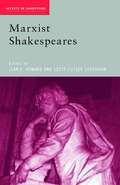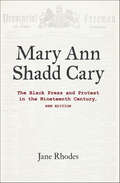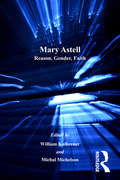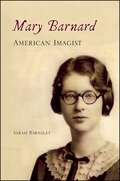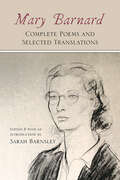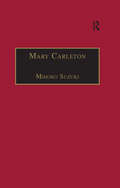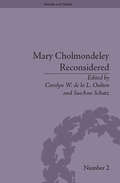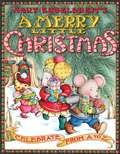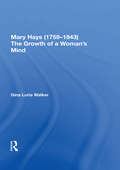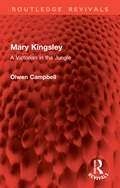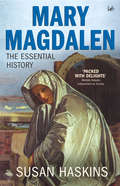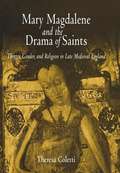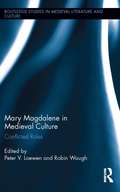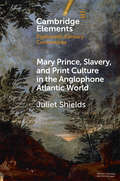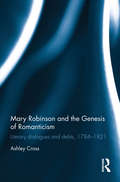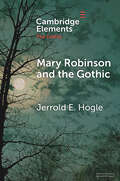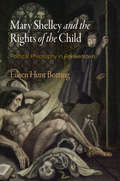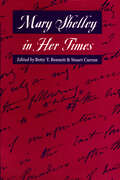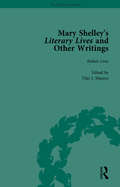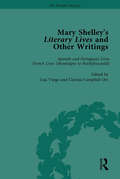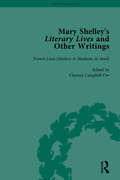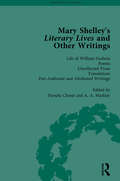- Table View
- List View
Marxist Shakespeares (Accents on Shakespeare)
by Jean E. HowardMarxist Shakespeares uses the rich analytic resources of the Marxist tradition to look at Shakespeare's plays afresh. The book offers new insights into the historical conditions within which Shakespeare's representations of class and gender emerged, and into Shakespeare's role in the global culture industry stretching from Hollywood to the Globe Theatre. A vital resource for students of Shakespeare which includes Marx's own readings of Shakespeare, Derrida on Marx, and also Bourdieu, Bataillle, Negri and Alice Clark.
Mary Ann Shadd Cary: The Black Press and Protest in the Nineteenth Century
by Jane RhodesMary Ann Shadd Cary was a courageous and outspoken nineteenth-century African American who used the press and public speaking to fight slavery and oppression in the United States and Canada. Part of the small free black elite who used their education and limited freedoms to fight for the end of slavery and racial oppression, Shadd Cary is best known as the first African American woman to publish and edit a newspaper in North America. But her importance does not stop there. She was an active participant in many of the social and political movements that influenced nineteenth century abolition, black emigration and nationalism, women's rights, and temperance. Mary Ann Shadd Cary: The Black Press and Protest in the Nineteenth Century explores her remarkable life and offers a window on the free black experience, emergent black nationalisms, African American gender ideologies, and the formation of a black public sphere. This new edition contains a new epilogue and new photographs.
Mary Astell and John Norris: Letters Concerning the Love of God (The Early Modern Englishwoman, 1500-1750: Contemporary Editions)
by Melvyn NewGiven the progress made in recent years in recovering the writings of early modern women, one might expect that a complete set of the important works of Mary Astell (1666-1731) would have been reissued long before now. Instead, only portions of the thought of the 'First English Feminist' have reached a wide academic audience. This volume presents a critical and annotated edition of the correspondence between Astell and John Norris of Bemerton (1657-1711), Letters Concerning the Love of God, which was published in three separate editions during the seventeenth and eighteenth centuries (1695, 1705, 1730). This work had profound significance in eighteenth-century intellectual and religious circles, and represents a crucial step in the development of Norris and Astell's philosophical and theological opposition to that most prominent of Enlightenment figures, John Locke. Letters Concerning the Love of God includes, as contextual material, Norris's Cursory Reflections upon a Book Call'd, An Essay Concerning Human Understanding (1690), the first published philosophical response to (as Bishop Stillingfleet would later put it) Locke's 'new way of ideas,' and Astell's biting and comprehensive attack on Locke in the 'Appendix' to the second edition of The Christian Religion, As Professed by a Daughter of the Church of England (1717). These texts serve to place both Letters and its authors in the contentious philosophical-theological climate to which they belonged, one wherein, most significantly, Locke's present-day preeminence had yet to be realized. The editors' extensive introduction and annotations to this volume not only provide background on the historical and biographical elements, but also elucidate philosophical and theological concepts that are perhaps unfamiliar to modern readers.
Mary Astell: Reason, Gender, Faith
by William KolbrenerMary Astell: Reason, Gender, Faith includes essays from diverse disciplinary perspectives to consider the full range of Astell's political, theological, philosophical, and poetic writings. The volume does not eschew the more traditional scholarly interest in Astell's concerns about gender; rather, it reveals how Astell's works require attention not only for their role in the development of early modern feminism, but also for their interventions on subjects ranging from political authority to educational theory, from individual agency to divine service, and from Cartesian ethics to Lockean epistemology. Given the vast breadth of her writings, her active role within early modern political and theological debates, and the sophisticated complexity of her prose, Astell has few parallels among her contemporaries. Mary Astell: Reason, Gender, Faith bestows upon Astell the attention which she deserves not merely as a proto-feminist, but as a major figure of the early modern period.
Mary Barnard, American Imagist
by Sarah BarnsleyPerhaps best known for her outstanding translation of Sappho, poet Mary Barnard (1909–2001) has until recently received little attention for her own work. In this book, Sarah Barnsley examines Barnard's poetry and poetics in the light of her plentiful correspondence with Ezra Pound, William Carlos Williams, and others. Presenting Barnard as a "late Imagist," Barnsley links Barnard's search for a poetry grounded in native speech to efforts within American modernism for new forms in the American grain. Barnsley finds that where Pound and Williams began the campaign for a modern poetry liberated from the "heave" of the iambic pentameter, Barnard completed it through a "spare but musical" aesthetic derived from her studies of Greek metric and American speech rhythms, channeled through materials drawn direct from the American local. The first book on Barnard, and the first to draw on the Barnard archives at Yale's Beinecke Library, Mary Barnard, American Imagist unearths a fascinating and previously untold chapter of twentieth-century American poetry.
Mary Barnard: Complete Poems and Selected Translations
by Mary BarnardThe most comprehensive collection of writing by award-winning US poet, renowned translator of Sappho, and trailblazing archivist Mary Barnard.Born in the Pacific Northwest, Mary Barnard (1909–2001) struck up correspondence with Ezra Pound in 1933, won Poetry magazine's prestigious Levinson Award in 1935, and moved to New York City the following year. There she met Marianne Moore and William Carlos Williams, who proclaimed her writing emblematic of "what we have been about all these years." This fully annotated volume makes available Barnard's complete poems for the first time, along with a robust selection of her translations and prose. Most well-known for her bestselling Sappho and her influential role as the inaugural poetry curator at the University at Buffalo, Barnard was a "second-wave" modernist and "late" Imagist whose regionally grounded writing also anticipated later eco-poetry. The volume's editor, Barnard scholar and biographer Sarah Barnsley, situates Barnard's work within these broader literary and cultural currents. Previously unpublished poems appear alongside Barnard's essays on her creative practice and friendships, illuminating the career, oeuvre, and ethos of this pivotal yet still underappreciated twentieth-century figure. With a foreword by Mary de Rachewiltz (author of Ezra Pound, Father and Teacher) and afterword by Barnard's literary executor Elizabeth J. Bell, Mary Barnard is essential reading for poets, scholars, and translators.
Mary Carleton: Printed Writings 1641–1700: Series II, Part Three, Volume 6 (The Early Modern Englishwoman: A Facsimile Library of Essential Works & Printed Writings, 1641-1700: Series II, Part Three #Vol. 6)
by Mihoko SuzukiMary Carleton, commonly known as the German Princess, was a scandalous celebrity in Restoration London. Her notoriety arose from her 1663 trial and acquittal for bigamy, which became the occasion of the publication of The Case of Madam Mary Carleton. Here she narrates her version of her life as a 'German Princess', the daughter of the Earl of Cologne, though by most accounts she was born Mary Moders, the daughter of a Canterbury fiddler who married first a Canterbury shoemaker, Thomas Steadman, and then a surgeon, Thomas Day. Within her own time, Carleton was the subject of more than twenty-six pamphlets published in 1663 and 1673; this volume reprints Carleton's own The Case of Madam Mary Carleton along with representative selections of pamphlets written about her. Her trial produced its own 'pamphlet war' between Mary and her husband John and her story inspired a play and a mock epic, which significantly responded to Carleton's own emphasis on performance and epic romance in fashioning her aristocratic identity.
Mary Cholmondeley Reconsidered (Gender and Genre #2)
by Carolyn W. de la L. Oulton SueAnn SchatzThis book provides a necessary critical reappraisal of one of the most challenging and subversive of nineteenth-century women writers.
Mary Engelbreit's A Merry Little Christmas: Celebrate from A to Z
by Mary EngelbreitWelcome to a winter wonderland!Christmas is coming, but there's still so much to do!In their tiny village in the woods, Gregory Mouse and his family are just as busy as Santa and his elves. They have gingerbread houses to decorate, presents to wrap, cookies to bake, and snowy hills to sled—all before the celebration begins!This playful holiday alphabet book offers children a miniature world filled with wonderful details—a treat that could only come from Mary Engelbreit, the beloved artist whose bestselling edition of The Night Before Christmas is already a classic.
Mary Hays (1759-1843): The Growth of a Woman's Mind
by Gina Luria WalkerMary Hays, reformist, novelist, and innovative thinker, has been waiting two hundred years to be judged in a fair, scholarly, and comprehensive way. During her lifetime and long after, her role in the ongoing reformist debates in England at the end of the eighteenth century, intensified by the French Revolution, served as a lightening rod for opponents who attacked her controversial stance on women's intellectual competence and human rights. The author's intellectual history of Hays finally makes the case for her importance as an innovator. She was a feminist thinker who advanced notions of tolerance that included women, an educator who broke new ground for female autodidacts, a philosophical commentator who translated Enlightenment ideas for a burgeoning female audience, a Dissenting historiographer who reinvented 'female biography,' and a writer of deliberately experimental fiction, including the roman à clef Memoirs of Emma Courtney. The author approaches Hays from several disciplinary perspectives-historical, biographical, literary, critical, theological, and political-to elucidate the multiple ways in which Hays contributed and responded to, and influenced and was influenced by, the most significant issues and figures of her time.
Mary Kingsley: A Victorian in the Jungle (Routledge Revivals)
by Olwen CampbellThe name of Mary Kingsley deserves to be more widely known than it is today. A woman of rare abilities and boundless courage, living in an age when the narrowest Victorian conventions about the duties of daughters in the home still prevailed, she nevertheless achieved fame and distinction as a traveller in the wildest regions of West Africa, a writer, an ethnologist, and an expert on Colonial Government.As a young woman, Mary Kingsley had no life beyond the strict confines of her home; not until 1892, when she was thirty, did freedom come to her. Instantly this astonishing young woman began the work, which was to lead her to remote, unexplored regions of ‘the Coast’. Along unmapped rivers, to a study of cannibals, and in England, to a political struggle to which she wholeheartedly gave herself for the welfare of the peoples of West Africa, until her death in 1900.In vivid, discursive travel books, Mary Kingsley described her experiences with immense detachment and humour. These lengthy works have long been out of print, but in Mary Kingsley: A Victorian in the Jungle (first published in 1957.) Olwen Campbell, by presenting selected extracts, preserves in a concise form the record of these strange adventures. But the adventures themselves are only a part of a remarkable life story. The effects on Mary Kingsley’s character of her oppressive home life are fully brought out for the first time, and some explanation is suggested of a most enigmatic personality. Fresh light is also thrown on her political work, and her character, by a number of extracts from a series of remarkable letters, never before published.
Mary Magdalen: Truth and Myth
by Susan HaskinsA dramatic, thought-provoking portrait of one of the most compelling figures in early Christianity which explores two thousand years of history, art, and literature to provide a close-up look at Mary Magdalen and her significance in religious and cultural thought.
Mary Magdalene and the Drama of Saints
by Theresa ColettiA sinner-saint who embraced then renounced sexual and worldly pleasures; a woman who, through her attachment to Jesus, embodied both erotic and sacred power; a symbol of penance and an exemplar of contemplative and passionate devotion: perhaps no figure stood closer to the center of late medieval debates about the sources of spiritual authority and women's contribution to salvation history than did Mary Magdalene, and perhaps nowhere in later medieval England was cultural preoccupation with the Magdalene stronger than in fifteenth-century East Anglia.Looking to East Anglian texts including the N-Town Plays, The Book of Margery Kempe, The Revelations of Julian of Norwich, and Bokenham's Legend of Holy Women, Theresa Coletti explores how the gendered symbol of Mary Magdalene mediates tensions between masculine and feminine spiritual power, institutional and individual modes of religious expression, and authorized and unauthorized forms of revelation and sacred speech. Using the Digby play Mary Magdalene as her touchstone, Coletti engages a wide variety of textual and visual resources to make evident the discursive and material ties of East Anglian dramatic texts and feminine religion to broader traditions of cultural commentary and representation.In bringing the disciplinary perspectives of literary history and criticism, gender studies, and social and religious history to bear on specific local instances of dramatic practice, Mary Magdalene and the Drama of Saints highlights the relevance of Middle English dramatic discourse to the dynamic religious climate of late medieval England. In doing so, the book decisively challenges the marginalization of drama within medieval English studies, elucidates vernacular theater's kinship with influential late medieval religious texts and institutions, and articulates the changing possibilities for sacred representation in the decades before the Reformation.
Mary Magdalene in Medieval Culture: Conflicted Roles
by Robin Waugh Peter V. LoewenThis innovative and multidisciplinary collection visits representations and interpretations of Mary Magdalene in the medieval and early modern periods, questioning major scholarly assumptions behind the examination of female saints and their depictions in medieval artworks, literature, and music. Mary Magdalene’s many and various characterizations from reformed prostitute to conversion-figure to devotee of Christ to "apostle to the apostles" to spiritual advisor to the Prince of Marseilles to hermit in the desert, to list just a few examples, mean that the many conflicted representations of Mary Magdalene apply to a staggering variety of cultural material, including art, liturgy, music, literature, theology, hagiography, and the historical record. Furthermore, Mary Magdalene has grown into an extremely popular and controversial figure due to recent books and movies concerning her, and due to a groundswell of general speculation concerning her relationship to Jesus: was she his acquaintance, follower, companion, wife, family-member, or lover? This volume employs a broad spectrum of theoretical methodologies in order to present poststructuralist, postcolonial, postmodernist, hagiographic, and feminist readings of the figure of Mary Magdalene, addressing and interrogating her conflicting roles and the precise relationship between her sacred and secular representations.
Mary Prince, Slavery, and Print Culture in the Anglophone Atlantic World (Elements in Eighteenth-Century Connections)
by Juliet ShieldsThis study examines a network of writers that coalesced around the publication of The History of Mary Prince (1831), which recounts Prince's experiences as an enslaved person in the West Indies and the events that brought her to seek assistance from the Anti-Slavery Society in London. It focuses on the three writers who produced the text - Mary Prince, Thomas Pringle, and Susanna Moodie - with glances at their pro-slavery opponent, James MacQueen, and their literary friends and relatives. The History connects the Black Atlantic, a diasporic formation created through the colonial trade in enslaved people, with the Anglophone Atlantic, created through British migration and colonial settlement. It also challenges Romantic ideals of authorship as an autonomous creative act and the literary text as an aesthetically unified entity. Collaborating with Prince on the History's publication impacted Moodie's and Pringle's attitudes towards slavery and shaped their own accounts of migration and settlement.
Mary Robinson and the Genesis of Romanticism: Literary Dialogues and Debts, 1784–1821
by Ashley CrossFirst coming to prominence as an actress and scandalous celebrity, Mary Robinson created an identity for herself as a Romantic poet and novelist in the 1790s. Through a series of literary dialogues with established writers, Robinson put herself at the center of Romantic literary culture as observer, participant, and creator. Cross argues that Robinson’s dialogues shaped the nature of Romantic writing both in content and form and influenced second-generation Romantics. These dialogues further establish the idea of Romantic discourse as essentially interactive and conversational, not the work of original geniuses working in isolation, and positions Robinson as a central player in its genesis.
Mary Robinson and the Genesis of Romanticism: Literary Dialogues and Debts, 1784–1821
by Ashley CrossFirst coming to prominence as an actress and scandalous celebrity, Mary Robinson created an identity for herself as a Romantic poet and novelist in the 1790s. Through a series of literary dialogues with established writers, Robinson put herself at the center of Romantic literary culture as observer, participant, and creator. Cross argues that Robinson’s dialogues shaped the nature of Romantic writing both in content and form and influenced second-generation Romantics. These dialogues further establish the idea of Romantic discourse as essentially interactive and conversational, not the work of original geniuses working in isolation, and positions Robinson as a central player in its genesis.
Mary Robinson and the Gothic (Elements in the Gothic)
by Jerrold E. HogleCelebrated as an actress on the London stage (1776–80) and notorious as the mistress of the Prince of Wales (1779–80), Mary Darby Robinson had to write to support herself from the mid–1780s until her death in 1800. She mastered a wide range of styles, published prolifically, and became the poetry editor of the Morning Post. As her writing developed across the 1790s, she increasingly used the motifs of Gothic fiction and drama descended from Horace Walpole's Castle of Otranto (1764). These came to pervade her late novels and poems so much that she even wrote her autobiography as a Gothic romance. She also deployed them to critique the ideologies of male dominance and the forms of writing in which they appeared. This progression culminated in her final collection of verses, Lyrical Tales (1800), where she Gothically exposes the conflicted underpinnings in the now-famous Lyrical Ballads (1798) by Wordsworth and Coleridge.
Mary Shelley and the Rights of the Child: Political Philosophy in "Frankenstein"
by Eileen Hunt BottingFrom her youth, Mary Shelley immersed herself in the social contract tradition, particularly the educational and political theories of John Locke and Jean-Jacques Rousseau, as well as the radical philosophies of her parents, the feminist Mary Wollstonecraft and the anarchist William Godwin. Against this background, Shelley wrote Frankenstein; or, the Modern Prometheus, first published in 1818. In the two centuries since, her masterpiece has been celebrated as a Gothic classic and its symbolic resonance has driven the global success of its publication, translation, and adaptation in theater, film, art, and literature. However, in Mary Shelley and the Rights of the Child, Eileen Hunt Botting argues that Frankenstein is more than an original and paradigmatic work of science fiction—it is a profound reflection on a radical moral and political question: do children have rights?Botting contends that Frankenstein invites its readers to reason through the ethical consequences of a counterfactual premise: what if a man had used science to create a human life without a woman? Immediately after the Creature's "birth," his scientist-father abandons him and the unjust and tragic consequences that follow form the basis of Frankenstein's plot. Botting finds in the novel's narrative structure a series of interconnected thought experiments that reveal how Shelley viewed Frankenstein's Creature for what he really was—a stateless orphan abandoned by family, abused by society, and ignored by law. The novel, therefore, compels readers to consider whether children have the right to the fundamental means for their development as humans—namely, rights to food, clothing, shelter, care, love, education, and community.In Botting's analysis, Frankenstein emerges as a conceptual resource for exploring the rights of children today, especially those who are disabled, stateless, or genetically modified by medical technologies such as three-parent in vitro fertilization and, perhaps in the near future, gene editing. Mary Shelley and the Rights of the Child concludes that the right to share love and community, especially with parents or fitting substitutes, belongs to all children, regardless of their genesis, membership, or social status.
Mary Shelley in Her Times
by Betty T. Bennett and Stuart CurranAuthor of six novels, five volumes of biographical lives, two travel books, and numerous short stories, essays, and reviews, Mary Shelley is largely remembered as the author of Frankenstein, as the wife of Percy Bysshe Shelley, and as the daughter of William Godwin and Mary Wollstonecraft. This collection of essays, edited by Betty T. Bennett and Stuart Curran, offers a more complete and complex picture of Mary Shelley, emphasizing the full range and significance of her writings in terms of her own era and ours. Mary Shelley in Her Times brings fresh insight to the life and work of an often neglected or misunderstood writer who, the editors remind us, spent nearly three decades at the center of England's literary world during the country's profound transition between the Romantic and Victorian eras.The essays in this volume demonstrate the importance of Mary Shelley's neglected novels, including Matilda, Valperga, The Last Man, and Falkner. Other topics include Mary Shelley's work in various literary genres, her editing of her husband's poetry and prose, her politics, and her trajectory as a female writer. This volume advances Mary Shelley studies to a new level of discourse and raises important issues for English Romanticism and women's studies.
Mary Shelley in Her Times
by Betty T. Bennett and Stuart Curran“Some of the strongest essays of recent times on Shelley’s work . . . A valuable piece of criticism.” —Byron JournalMary Shelley is largely remembered as the author of Frankenstein, as the wife of Percy Bysshe Shelley, and as the daughter of William Godwin and Mary Wollstonecraft. This collection of essays, edited by Betty T. Bennett and Stuart Curran, offers a more complete and complex picture of Mary Shelley—author of six novels, five volumes of biographical lives, two travel books, and numerous short stories, essays, and reviews—emphasizing the full range and significance of her writings in terms of her own era and ours. Mary Shelley in Her Times brings fresh insight to the life and work of an often neglected and misunderstood writer who, the editors remind us, spent nearly three decades at the center of England’s literary world during the country’s profound transition between the Romantic and Victorian eras.The essays in this volume demonstrate the importance of Mary Shelley’s neglected novels, including Matilda, Valperga, The Last Man, and Falkner. Other topics include her work in various literary genres, her editing of her husband’s poetry and prose, her politics, and her trajectory as a female writer. This volume advances Mary Shelley studies to a new level of discourse and raises important issues for English Romanticism and women’s studies.
Mary Shelley's Literary Lives and Other Writings, Volume 1
by Nora CrookThis collection covers the lyrical poetry of Mary Shelley, as well as her writings for Lardner's "Cabinet Cyclopaedia of Biography" and some other materials only recently attributed to her.
Mary Shelley's Literary Lives and Other Writings, Volume 2: Spanish And Portuguese Lives
by Lisa VargoThis collection covers the lyrical poetry of Mary Shelley, as well as her writings for Lardner's "Cabinet Cyclopaedia of Biography" and some other materials only recently attributed to her.
Mary Shelley's Literary Lives and Other Writings, Volume 3
by Nora CrookThis collection covers the lyrical poetry of Mary Shelley, as well as her writings for Lardner's "Cabinet Cyclopaedia of Biography" and some other materials only recently attributed to her.
Mary Shelley's Literary Lives and Other Writings, Volume 4
by Nora CrookThis collection covers the lyrical poetry of Mary Shelley, as well as her writings for Lardner's "Cabinet Cyclopaedia of Biography" and some other materials only recently attributed to her.
